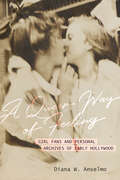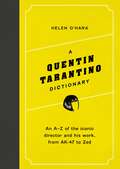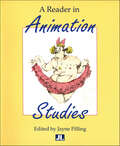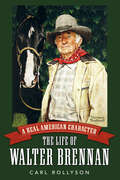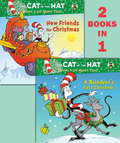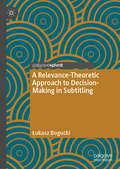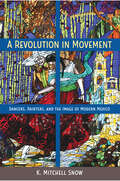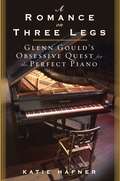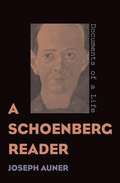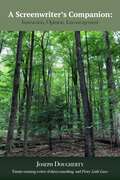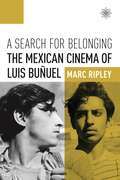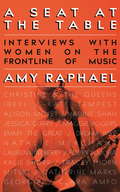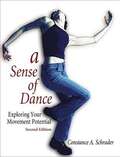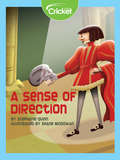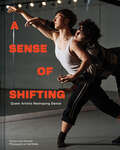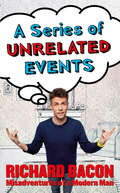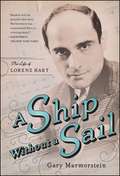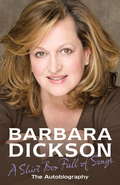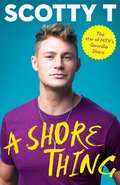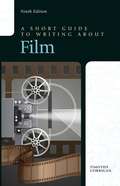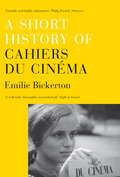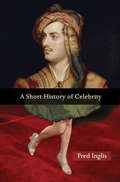- Table View
- List View
A Queer Way of Feeling: Girl Fans and Personal Archives of Early Hollywood (Feminist Media Histories #4)
by Diana W. AnselmoA Queer Way of Feeling gathers an unexplored archive of fan-made scrapbooks, letters, diaries, and photographs to explore how girls coming of age in the United States in the 1910s used cinema to forge a foundational language of female nonconformity, intimacy, and kinship. Pasting cross-dressed photos into personal scrapbooks and making love to movie actresses in epistolary writing, girl fans from all walks of life stitched together established homoerotic conventions with an emergent syntax of film stardom to make sense of feeling "queer" or "different from the norm." These material testimonies show how a forgotten audience engendered terminologies, communities, and creative practices that became cornerstones of media fan reception and queer belonging.
A Quentin Tarantino Dictionary: An A–Z of the iconic director and his work, from AK-47 to Zed (Director Dictionaries)
by Helen O'HaraExplore an A-Z of everything you need to know about the masterful movies of Quentin Tarantino, from AK-47 to "Zed's dead, baby" and everything in between.With hundreds of entries covering every facet of Tarantino's work - from inspiration and influences to his most frequent collaborators and little-known cameos - A Quentin Tarantino Dictionary is a stylish guide to the wonderful world of this visionary filmmaker.Written by author and film critic Helen O'Hara (Empire, BAFTA, the Telegraph) and with bespoke illustrations that bring the director's vision to life, this is a one-stop shop for all things Tarantino.
A Quentin Tarantino Dictionary: An A–Z of the iconic director and his work, from AK-47 to Zed (Director Dictionaries)
by Helen O'HaraExplore an A-Z of everything you need to know about the masterful movies of Quentin Tarantino, from AK-47 to "Zed's dead, baby" and everything in between.With hundreds of entries covering every facet of Tarantino's work - from inspiration and influences to his most frequent collaborators and little-known cameos - A Quentin Tarantino Dictionary is a stylish guide to the wonderful world of this visionary filmmaker.Written by author and film critic Helen O'Hara (Empire, BAFTA, the Telegraph) and with bespoke illustrations that bring the director's vision to life, this is a one-stop shop for all things Tarantino.
A Reader in Animation Studies
by Jayne PillingCartoons—both from the classic Hollywood era and from more contemporary feature films and television series—offer a rich field for detailed investigation and analysis. Contributors draw on theories and methodology from film, television, and media studies, art history and criticism, and feminism and gender studies.
A Real American Character: The Life of Walter Brennan (Hollywood Legends Series)
by Carl RollysonWalter Brennan (1894-1974) was one of the greatest character actors in Hollywood history. He won three Academy Awards and became a national icon starring as Grandpa in The Real McCoys. He appeared in over two hundred motion pictures and became the subject of a Norman Rockwell painting, which celebrated the actor's unique role as the voice of the American Western. His life journey from Swampscott, Massachusetts, to Hollywood, to a twelve thousand-acre cattle ranch in Joseph, Oregon, is one of the great American stories. In the first biography of this epic figure, Carl Rollyson reveals Brennan's consummate mastery of virtually every kind of role while playing against and often stealing scenes from such stars as Gary Cooper, Humphrey Bogart, and John Wayne. Rollyson fully explores Brennan's work with Hollywood's greatest directors, such as Howard Hawks, John Ford, and Fritz Lang. As a father and grandfather, Brennan instilled generations of his family with an outlook on the American Dream that remains a sustaining feature of their lives today. His conservative politics, which grew out of his New England upbringing and his devout Catholicism, receive meticulous attention and a balanced assessment in A Real American Character. Written with the full cooperation of the Brennan family and drawing on material in archives from every region of the United States, this new biography presents an artist and family man who lived and breathed an American idealism that made him the Real McCoy.
A Reindeer's First Christmas/New Friends for Christmas (Pictureback(R))
by Joe Mathieu Aristides Ruiz Tish RabeFans of the Cat in the Hat have cause to celebrate this holiday season with two stories based on the one-hour PBS Kids' primetime special The Cat in the Hat Knows a Lot About Christmas! In A Reindeer's First Christmas, narrator Ralph--a yearling caribou--tells how but for the help of the Cat in the Hat, Sally, Nick, and some new friends, he narrowly misses spending his first Christmas at home and pulling Santa's sled! And in New Friends for Christmas, Sally and Nick learn that with a little help from family and friends--and a spare mini Thinga-ma-jigger--its possible to accomplish almost anything!
A Relevance-Theoretic Approach to Decision-Making in Subtitling
by Łukasz BoguckiThis book aims to investigate the process of decision-making in subtitling of feature films and entertainment series. The author uses Relevance Theory (Sperber and Wilson,1986) to argue that the technical, linguistic and translational constraints at work in subtitling result in a curtailed target text, and illustrates this argument by invoking examples drawn from the English-Polish subtitles of films and television series available through the subscription service Netflix. After introducing the current state of research on audiovisual translation within and outside the framework of translation studies, he presents the core concepts underpinning Relevance Theory and explains how it can be used to construct a model of the process of subtitling. This book will be of interest to students and scholars working in the fields of translation studies, audiovisual translation studies, and communication studies.
A Revolution in Movement: Dancers, Painters, and the Image of Modern Mexico (Dancers, Painters, and the Image of Modern Mexico)
by K. Mitchell SnowHonorable Mention, Latin American Studies Association Mexico Section Best Book in the HumanitiesHow collaborations between dancers and painters shaped cultural identity in MexicoA Revolution in Movement is the first book to illuminate how collaborations between dancers and painters shaped Mexico’s postrevolutionary cultural identity. K. Mitchell Snow traces this relationship throughout nearly half a century of developments in Mexican dance—the emulation of Diaghilev’s Ballets Russes in the 1920s, the adoption of U.S.-style modern dance in the 1940s, and the creation of ballet-inspired folk dance in the 1960s.Snow describes the appearances in Mexico by Russian ballerina Anna Pavlova and Spanish concert dancer Tortóla Valencia, who helped motivate Mexico to express its own national identity through dance. He discusses the work of muralists and other visual artists in tandem with Mexico’s theatrical dance world, including Diego Rivera’s collaborations with ballet composer Carlos Chávez; Carlos Mérida’s leadership of the National School of Dance; José Clemente Orozco’s involvement in the creation of the Ballet de la Ciudad de México; and Miguel Covarrubias, who led the "golden age" of Mexican modern dance. Snow draws from a rich trove of historical newspaper accounts and other contemporary documents to show how these collaborations produced an image of modern Mexico that would prove popular both locally and internationally and continues to endure today.
A Romance on Three Legs: Glenn Gould's Obsessive Quest for the Perfect Piano
by Katie HafnerThe story of a legendary pianist's obsession with the unique, temperamental instrument he loved. Important figures in Gould's life are introduced including his nearly blind tuner.
A Schoenberg Reader: Documents of a Life
by Joseph Henry AunerArnold Schoenberg and his music have been objects of celebration, controversy, and vilification for more than a century, from the time of his first performances to the present day. Not surprisingly, in accounts of his life and works by both his champions and his critics the adjective Schoenbergian has come to mean so many things as to be almost meaningless.
A Screenwriter's Companion: Instruction, Opinion, Encouragement
by Joseph DoughertyEveryone wants to write for television, and now there's a book that teaches you how to do it by an author who has not only done it himself, but has won multiple awards in the process. &“I was a writer before I knew what a writer was.&” -Joseph DoughertyJoseph Dougherty has been a successful playwright and television writer, producer, and director for more than thirty years. He&’s written for breakthrough series that have changed the way we look at television drama, from thirtysomething to Pretty Little Liars, winning everything from Emmys to Teen Choice Awards along the way. In A Screenwriter&’s Companion,Dougherty offers insights and advice both practical and nonpractical to writers and would-be writers. Dougherty&’s voice comes off the page with anecdotes about the writing process, hard-learned tips for survival in &“the business,&” and reflections on the influences that led him to a successful career. Honestly, entertainingly, without cynicism, he gives readers permission to embrace the writer they want to be, so they can experience the rewards and satisfactions of writing. Beyond an insider&’s take on story and structure, dialogue, action and outlining, A Screenwriter&’s Companionis as much mentor as it is manual. With every insider observation about how to keep a potential producer reading till the last page of a script, there&’s encouragement to explore your thoughts and memories, things a writer needs to embrace in order to become more than &“a pro.&” In short, to see writing not as merely a career, but as a way to greater self-understanding. With a Foreword by Scott Ryan (thirtysomething at thirty: an oral history). This book was selected by Foreword Magazine as one of the Best Gift Items of Fall 2022.
A Search for Belonging: The Mexican Cinema of Luis Buñuel
by Marc RipleyAs one of the foremost Spanish directors of all time, Luis Buñuel’s filmography has been the subject of innumerable studies. Despite the fact that the twenty films he made in Mexico between 1947 and 1965 represent the most prolific stage of his career as a filmmaker, these have remained relatively neglected in writing on Buñuel and his work. This book focuses on nine of the director’s films made in Mexico in order to show that a concerted focus on space, an important aspect of the films’ narratives that is often intimated by scholars, yet rarely developed, can unlock new philosophical meaning in this rich body of work.Although in recent years Buñuel’s Mexican films have begun to enjoy a greater presence in criticism on the director, they are often segregated according to their perceived critical value, effectively creating two substrands of work: the independent movies and the studio potboilers. The interdisciplinary approach of this book unites the two, focusing on films such as Los olvidados, Nazarín, and El ángel exterminador alongside La Mort en ce jardin, The Young One, and Simón del desierto, among others. In doing so, it avoids the tropes most often associated with Buñuel’s cinema—surrealism, Catholicism, the derision of the bourgeoisie—and the approach most often invoked in analysis of these themes: psychoanalysis. Instead, this book takes inspiration from the fields of human geography, anthropology, and philosophy, applying these to film-focused readings of Buñuel’s Mexican cinema to argue that ultimately these films depict an overriding sense of placelessness, overtly or subliminally enacting a search for belonging that forces the viewer to question what it means to be in place.
A Seat at the Table: Interviews with Women on the Frontline of Music
by Amy Raphael'Fascinating and illuminating' STYLIST'Perceptive and candid' IRISH TIMES'Wide-ranging, deep-dive, soul-baring interviews, full of candid, intimate, spiky meditations on inspiration, artistry, sexuality, race, love, self-doubt, abuse, defiance and everything in between' OBSERVER'Variously optimistic, troubling, joyful, illuminating, fierce and thoughtful' GUARDIANINTERVIEWS WITH WOMEN ON THE FRONTLINE OF MUSICWriter and critic Amy Raphael has interviewed some of the world's most iconic musicians, including Courtney Love, Patti Smith, Björk, Kurt Cobain and Elton John. In 1995 she wrote the critically-acclaimed Never Mind the Bollocks: Women Rewrite Rock, which included a foreword by Debbie Harry. More than two decades on, the music business has changed, but the way women are regarded has not. In this new book, A Seat at the Table, Raphael interviews eighteen women who work in the music industry about learning to speak out, #MeToo, social media, queer politics and the subtleness of everyday misogyny. Featuring interviews with:CHRISTINE & THE QUEENS, IBEYI, KAE TEMPEST, ALISON MOYET, NADINE SHAH, JESSICA CURRY, MAGGIE ROGERS, EMMY THE GREAT, DREAM WIFE, NATALIE MERCHANT, LAUREN MAYBERRY, POPPY AJUDHA, KALIE SHORR, TRACEY THORN, MITSKI, CATHERINE MARKS, GEORGIA, CLARA AMFO
A Sense of Direction
by Stephanie QuinnStage directions are instructions an actor follows in performing a play. They help the director tell the actors where to go on the stage.
A Sense of Shifting: Queer Artists Reshaping Dance
by Coco RomackEnter the groundbreaking world of queer dance in this gorgeous collection of stories and photographs.Two women hold each other tight as they dance the two-step. A fierce-eyed man in a long red dress performs flamenco. A dancer improvises in a blooming garden, blending diverse influences into a style all their own. This book showcases twelve individual artists and dance companies who are reclaiming traditional genres and building inclusive dance communities. Whether professionals or amateurs, ballerinas or experimental performers, pole dancers or line dancers, these artists embody the queer experience in unique ways. Photographer Yael Malka invites us into an intimate, visceral experience of rehearsals and performances, and writer Coco Romack offers wide-ranging reflections on the creative process drawn from in-depth interviews with the dancers. This beautiful book documents the rise of a new generation of artists and will inspire dance lovers, LGBTQIA+ creators, and anyone who delights in the power of the human body in motion.INSPIRING STORIES: The stories in this book represent a distinctive slice of the LGBTQIA+ experience. For dancers, whose art form is inseparable from their bodies, gender expression entwines with creative expression in challenging and liberating ways. The artists featured here generously explore their journeys in the interviews, while the photographs show the joy to be found in the queer dance community.BEAUTIFUL PRIDE GIFT: This collection is the perfect gift for anyone interested in the intersections of art, identity, and activism. With a deluxe art-book treatment and stunning photographs, the book can be proudly displayed on your coffee table or presented to the creative activist in your life.INCLUSIVE AND INTERSECTIONAL: This collection highlights a truly diverse array of experiences. The stories delve into the experiences of dancing in a wheelchair, navigating the intersections of gender and race, engaging with cultural inheritance on one's own terms, and even striving to make non-activist art when simply existing as a queer person can be a political action. The various dance styles and body types featured emphasize this book's welcoming, inclusive tone. Whether you love to dance or watch from the audience, identify as LGBTQIA+ or as an ally, this book is for you.Perfect for:Dancers and dance enthusiastsPeople interested in contemporary dance styles and dance companiesFans of portrait and performance photographyLGBTQIA+ artists, activists, and alliesReaders seeking inspiring art and storiesFans of portrait anthologies and storytelling projects like Humans of New YorkFans of LGBTQIA+ photobooks like Loving: a Photographic History of Men In Love 1850s–1950s, We Are Everywhere, and Queer Love In Color
A Series of Unrelated Events
by Richard BaconHave you ever been stitched up to the national press by your best mate?Or unintentionally upset a band with a slip of the tongue on a live TV show?Or ruined a dinner party by transforming everything alcoholic into water?Hello. I’m Richard Bacon and this is A Series of Unrelated Events. All of the stories are true. All of them happened to me. I’ve made the mistakes so you don’t have to (you’re welcome). So now, if you should ever find yourself sobbing on top of a box of gherkins in the stockroom of a Mansfield McDonald’s… having a Twitter conversation with your mum while she’s pretending to be an illiterate dog… performing stand-up to an audience who are funnier than you are… or just letting down all of the children of Great Britain……you’ll know exactly what to do.
A Ship Without A Sail: The Life of Lorenz Hart
by Gary MarmorsteinAn unforgettable portrait of an exuberant yet troubled artist who so enriched the American songbook "Blue Moon, " "Where or When, " "The Lady Is a Tramp," "My Funny Valentine," "Isn't It Romantic?," "My Romance," "There's a Small Hotel," "Falling in Love with Love," "Bewitched, Bothered and Bewildered"--lyricist Lorenz Hart, together with composer Richard Rodgers, wrote some of the most memorable songs ever created. More than half a century after their collaboration ended, Rodgers & Hart songs are indispensable to the repertoire of nightclub singers everywhere. A Ship Without a Sail is the story of the complicated man who was Lorenz Hart. His lyrics spin with brilliance and sophistication, yet at their core is an unmistakable wistfulness. The sweetness of "My Romance" and "Isn't It Romantic?" is unsurpassed in American song, but Hart's lyrics could also be cynical, funny, ironic. He brought a unique wit and elegance to popular music. Larry Hart and Richard Rodgers wrote approximately thirty Broadway musicals and dozens of songs for Hollywood films. At least four of their musicals--On Your Toes, Babes in Arms, The Boys from Syracuse, and Pal Joey-- have become classics. But despite their prodigious collaboration, Rodgers and Hart were an odd couple. Rodgers was precise, punctual, heterosexual, handsome, and eager to be accepted by Society. Hart was barely five feet tall, alcoholic, homosexual, and more comfortable in a bar or restaurant than anywhere else. Terrified of solitude, he invariably threw the party and picked up the check. His lyrics are all the more remarkable considering that he never sustained a romantic relationship, living his entire life with his mother, who died only months before he died at age forty-eight. Gary Marmorstein's revelatory biography includes many of the lyrics that define Hart's legacy--those clever, touching stanzas that still move us or make us laugh.
A Ship without a Sail: The Life of Lorenz Hart
by Gary MarmorsteinAn unforgettable portrait of an exuberant yet troubled artist who so enriched the American songbook "Blue Moon, " "Where or When, " "The Lady Is a Tramp," "My Funny Valentine," "Isn't It Romantic?," "My Romance," "There's a Small Hotel," "Falling in Love with Love," "Bewitched, Bothered and Bewildered"--lyricist Lorenz Hart, together with composer Richard Rodgers, wrote some of the most memorable songs ever created. More than half a century after their collaboration ended, Rodgers & Hart songs are indispensable to the repertoire of nightclub singers everywhere. A Ship Without a Sail is the story of the complicated man who was Lorenz Hart. His lyrics spin with brilliance and sophistication, yet at their core is an unmistakable wistfulness. The sweetness of "My Romance" and "Isn't It Romantic?" is unsurpassed in American song, but Hart's lyrics could also be cynical, funny, ironic. He brought a unique wit and elegance to popular music. Larry Hart and Richard Rodgers wrote approximately thirty Broadway musicals and dozens of songs for Hollywood films. At least four of their musicals--On Your Toes, Babes in Arms, The Boys from Syracuse, and Pal Joey-- have become classics. But despite their prodigious collaboration, Rodgers and Hart were an odd couple. Rodgers was precise, punctual, heterosexual, handsome, and eager to be accepted by Society. Hart was barely five feet tall, alcoholic, homosexual, and more comfortable in a bar or restaurant than anywhere else. Terrified of solitude, he invariably threw the party and picked up the check. His lyrics are all the more remarkable considering that he never sustained a romantic relationship, living his entire life with his mother, who died only months before he died at age forty-eight. Gary Marmorstein's revelatory biography includes many of the lyrics that define Hart's legacy--those clever, touching stanzas that still move us or make us laugh.
A Shirt Box Full of Songs: The Autobiography
by Barbara DicksonFrom singing to the postman when she was two years old to her annual sell-out tours in the 2000s, Barbara Dickson has been captivating her fans for the best part of sixty years. In her autobiography she describes the joys of growing up in Fife with her talented brother and loving parents, of moving to Edinburgh to find her place in the world and the stresses and strains of trying to make a living on the Scottish folk scene. Not content to have just a successful singing career, she turned to another: acting. A regular on prime-time television, Barbara also took to musicals and was the original lead role in Spend, Spend, Spend. Her hugely successful time onstage earned her many acting accolades but her pursuit of perfection led to complete exhaustion from which she fought hard to recover. Barbara writes beautifully about the close relationships she cultivated over these years with people such as Willy Russell, Elaine Paige and Billy Connolly. The result is a warm, fascinating story encompassing the best of British music, stage and television.
A Shirt Box Full of Songs: The Autobiography
by Barbara DicksonFrom singing to the postman when she was two years old to her annual sell-out tours in the 2000s, Barbara Dickson has been captivating her fans for the best part of sixty years. In her autobiography she describes the joys of growing up in Fife with her talented brother and loving parents, of moving to Edinburgh to find her place in the world and the stresses and strains of trying to make a living on the Scottish folk scene. Not content to have just a successful singing career, she turned to another: acting. A regular on prime-time television, Barbara also took to musicals and was the original lead role in Spend, Spend, Spend. Her hugely successful time onstage earned her many acting accolades but her pursuit of perfection led to complete exhaustion from which she fought hard to recover. Barbara writes beautifully about the close relationships she cultivated over these years with people such as Willy Russell, Elaine Paige and Billy Connolly. The result is a warm, fascinating story encompassing the best of British music, stage and television.
A Shore Thing
by Scotty TIn Geordie Shore star Scotty T's first ever book, we hear the tearaway 'Toon's exclusive, behind-the-scenes account of the MTV show. If you thought Scotty T's outrageous behaviour on Geordie Shore was just for the cameras, think again. Long before starring in the show, Scotty was living life to the fullest and getting up to all sorts. In this hilarious page turner, Scotty T will not only let slip scandalous secrets from Geordie Shore, Ex on the Beach and Celebrity Big Brother, but will open up about his antics when the cameras stop rolling. But it's not all sex, fights and getting mortal! Scotty also reveals a surprisingly softer side and opens up about living with ADHD, coping with the breakdown of his parents’ marriage and picking up the pieces after the loss of a loved one. The rascal also reflects on the lasses who have tried and failed to tame his heart and introduces us to the love of his life who has been living in the shadows all this time. And if all that wasn't enough, Scotty explains why he loves maths so much, what it was like to join the Neighbours cast, plus finally admits what he really thinks about his castmates, why he was nearly kicked off the show by producers and what life has in store for him after Geordie Shore.
A Short Guide To Writing About Film
by Timothy CorriganThis best-selling text is a succinct guide to thinking critically and writing precisely about film. Both an introduction to film study and a practical writing guide, this brief text introduces students to major film theories as well as film terminology, enabling them to write more thoughtfully and critically. With numerous student and professional examples, this engaging and practical guide progresses from taking notes and writing first drafts to creating polished essays and comprehensive research projects. Moving from movie reviews to theoretical and critical essays, the text demonstrates how an analysis of a film can become more subtle and rigorous as part of a compositional process.
A Short History of Cahiers du Cinema
by Emilie BickertonCahiers du Cinéma was the single most influential project in the history of film. Founded in 1951, it was responsible for establishing film as the 'seventh art,' equal to literature, painting or music, and it revolutionized film-making and writing. Its contributors would put their words into action: the likes of Godard, Truffaut, Rivette, Rohmer were to become some of the greatest directors of the age, their films part of the internationally celebrated nouvelle vague.In this authoritative new history, Emilie Bickerton explores the evolution and impact of Cahiers du Cinéma, from its early years, to its late-sixties radicalization, its internationalization, and its response to the television age of the seventies and eighties. Showing how the story of Cahiers continues to resonate with critics, practitioners and the film-going public, A Short History of Cahiers du Cinéma is a testimony to the extraordinary legacy and archive these 'collected pages of a notebook' have provided for the world of cinema.From the Hardcover edition.
A Short History of Celebrity
by Fred InglisLove it or hate it, celebrity is one of the dominant features of modern life--and one of the least understood. Fred Inglis sets out to correct this problem in this entertaining and enlightening social history of modern celebrity, from eighteenth-century London to today's Hollywood. Vividly written and brimming with fascinating stories of figures whose lives mark important moments in the history of celebrity, this book explains how fame has changed over the past two-and-a-half centuries. Starting with the first modern celebrities in mid-eighteenth-century London, including Samuel Johnson and the Prince Regent, the book traces the changing nature of celebrity and celebrities through the age of the Romantic hero, the European fin de siecle, and the Gilded Age in New York and Chicago. In the twentieth century, the book covers the Jazz Age, the rise of political celebrities such as Mussolini, Hitler, and Stalin, and the democratization of celebrity in the postwar decades, as actors, rock stars, and sports heroes became the leading celebrities. Arguing that celebrity is a mirror reflecting some of the worst as well as some of the best aspects of modern history itself, Inglis considers how the lives of the rich and famous provide not only entertainment but also social cohesion and, like morality plays, examples of what--and what not--to do. This book will interest anyone who is curious about the history that lies behind one of the great preoccupations of our lives.
